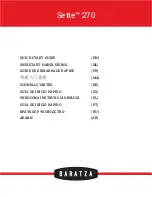
Operation
Version 1.0 - 2020-12-10
34
Translation of original operating instruction
GT22
EN
GT22_G
B_4
.f
m
If the disc continues to move, the two weights "K" must be moved symmetrically to the "S-G"
axis in the corresponding direction. Repeat this step until the disc stops moving.
4.10
Mounting the grinding wheel with flange on the spindle
Clean and lightly oil the spindle cone.
Clean the cone in the flange and place the grinding wheel with flange on the spindle cone
and fasten it with the spindle nut using the key.
Abb.4-2:
GT22
4.11
Selection of a grinding wheel
Factors for the grinding wheel quality:
Graining
Binding
Pores
Abrasives:
Quartz, corundum, emery, pumice, garnet and natural diamonds.
However, synthetically produced grain materials are mainly used, whose properties can be
adjusted by the manufacturing process.
These are corundum (Al2O3), silicon carbide (SiC), cubic boron nitride (CBN) and synthetically
produced diamond.
Corundum and silicon carbide belong to the group of conventional, cubic boron nitride and dia-
mond to the ultra-hard grinding materials.
Bonds used in grinding wheels are mainly synthetic resin bonds, ceramic bonds, metallic sin-
tered bonds and electroplated bonds.
However, rubber bonds and bonds made of polyurethane are also used when high surface
qualities are required.
Fillers and additives:
Fillers and supporting grains in resin bonds, which can increase strength, heat resistance and
toughness, or solid lubricants such as graphite or pyrite, which among other things reduce the
grinding temperatures that arise.
Factors for the processing quality:
Material removal - depending on grit size and grinding wheel material
Bond of the grinding wheel material - stability at high speeds.
Surface quality - depending on the grit and the grinding wheel material.
2
1
















































